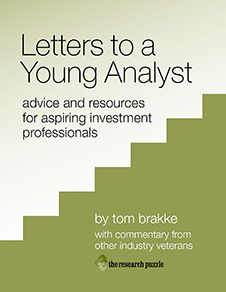
- Sunday, November 11th, 2012
- odds and errors
-
Surely one of the most interesting aspects of the election drama that just played out was the rise of Nate Silver as an icon of statistical reason — and as a lightening rod for criticism by those who disagreed with his conclusions (before they were proven to be amazingly accurate).
The fact that he turned out to be “right” cements Silver’s legacy, at least until he gets a major call “wrong” in the future, at which point we will hear a chorus of told-you-so catcalls. Thankfully, Silver has always been consistent in talking about his methods; his goal is to analyze the odds, not to carry a political torch or overstate the application of his findings.
The debate reminded me of some key issues in investment decision making, thus the inclusion of this posting in my ongoing series on equity research.the research puzzle | This PDF of the postings in the series is updated as they appear.
It is an easy analogy to draw between Silver’s work and quantitative methods for investment decision making. In each case, the historical record is parsed and judgments are made on the basis of the data at hand. There have been stocks selected and portfolios managed in that way for decades, and the approach forms the foundation of many algorithmic investment activities today. By definition, quantitative investment works best when things stay the same and worst when real change is afoot.
For the purposes of rhetorical contrast, “fundamental” investors are often portrayed as those who invest on a hunch rather than the data. That’s not a fair characterization, as many investors who make decisions qualitatively have a mastery of the numbers as well as the other factors that they consider. Unfortunately, when fundamental investors go wrong, they often make errors like the anti-Silver crowd did this election cycle.
Conservative pollsters and pundits convinced themselves that 2008 was an anomaly, that the intensity of support for Obama that year could not be replicated, that it was bad data that could be thrown out of an analysis. Certainly that was one possibility, but it was not treated as a possibility but as a foundational belief and was clung to by the believers in spite of contravening evidence.
Another problem was that the political echo chamber yielded reinforcement rather than enlightenment, as it always does. “Thought leaders” get wedded to their predictions and anchored by their conflicts of interest. They don’t abandon their positions until the facts disprove them (at which time it is too late) and even then mostly rationalize their errors rather than admit them.
As the returns started to come in, a telling report appeared on a live blog from the New York Times. With the evidence mounting that Romney would lose, those at his election party didn’t want to see the coverage being broadcast on CNN: “Every time the network is turned on, audience members at the Boston Convention Center chant for a change of channel. ‘Fox! Fox! Fox!’ they yell.” As if that could have helped.
It all reminded me of countless times I have seen investment managers (including me) fall in love with a thesis and a position even as facts and numbers started to pile up in opposition. Rather than embracing the new evidence and digging for more that might disprove your views, it’s easiest to listen to those that think like you do (perhaps a conflicted sell-side analyst) or those who are unlikely to give you the whole picture (such as company management). You start to engage in magical thinking and to see what you want to see.
There was lots of talk about the effect of momentum leading up to the election. In the investment world, momentum can lead to exaggerated moves in investment vehicles, as participants chase relative performance.
But that’s not the case in most political races. Absent an extraordinary development, relatively few voters are being fought over and momentum runs into a natural and substantial wall. That said, momentum did shift in Romney’s favor for a time. However, Silver was among the first to note that his momentum had stopped and reversed, and did so well in advance of the election, while Romney’s advocates proclaimed even until the fateful evening that it would carry him over the top. It was contrived momentum, without substance underneath.
Investment decision makers need to understand the power and limitations of each type of analysis: quantitative, qualitative, and momentum-driven. In the market, each has its day in the sun and each its day in the doghouse. But the real trick is to allow one to inform the other, to combine them in ways that match your investment beliefs,the research puzzle | This is a recent posting on the importance of clarity regarding your investment beliefs. and to be clear about the nature of your methods and the kinds of errors you are likely to make.
If you want to be more of an advocate than an analyst and put forward theories without much in the way of factual foundation, go right ahead. Just let those that believe in you know that your odds are long and the cost of failure might be very high.
